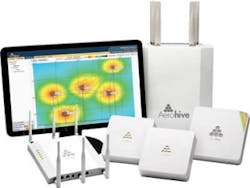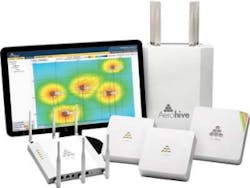Wireless pervasiveness continues on campus
Colleges and universities, already replete with wireless networks, strive to optimize their over-the-air connectivity.
By Patrick McLaughlin
ACUTA (www.acuta.org), which describes itself as the association for information communications technology professionals in higher education, conducted a focus group in 2010, as it had the previous year. In the summary report of that group meeting–the report can be found on the association's Web site–the group's conductor Dr. Mark Bannister, Dean of the College of Business and Leadership at Fort Hays State University in Kansas (www.fhsu.edu), provides aggregated information representing a consensus of the group.
Lubbock Christian University deployed Aerohive's wireless LAN technology, shown here, when upgrading its academic wireless LAN.
The first question posed to the ACUTA focus group asked about their vision of communications, computing and networked communications on college and university campuses in 2015. The report indicates the group's general response began as follows: "Students will be using multiple types of devices connected wirelessly to dependable, robust and secure networks." Exactly 10 words into the response to the first question asked, it is established that wireless connectivity will be a core necessity for colleges and universities.
The wireless concept shows up even earlier in the response to the next question, "What will be the characteristics of access devices and computing processing used by students?" The response: "Students will use wireless, multi-purpose multi-media handheld devices. Such devices will facilitate multi-tasking and will provide communication, delivery, feedback and assessment opportunities for classroom teaching and new distractions and challenges. Access devices will be handheld, e-commerce-enabled, and able to accommodate a variety of services."
Here and now
Despite the fact that this ACUTA focus group was envisioning and discussing the campus network of 2015, several of the communications needs they expressed are already emerging. 802.11-based wireless local area networks (LANs) pervade the campuses of higher-education institutions today and many of those campuses are cycling through the upgrade path from 802.11a/b/g to 802.11.n. A couple examples of these upgrades, featuring wireless LAN systems from two different providers, are featured in the remainder of this article.
Lubbock Christian University (www.lcu.edu) has approximately 1,800 students plus faculty and staff on its networks. To serve this population, the school installed two wireless networks–one covering academic areas of the campus and the other serving student housing. The system provides access to basic Web applications as well as academic tools and a video-recording application.
As described by Aerohive (www.aerohive.com), the company that provided Lubbock Christian University with wireless LAN technologies for the upgrade, by the end of the 2007-2008 academic year the academic wireless LAN's autonomous access points lacked centralized-management capabilities and were becoming unreliable. Sherri Hayes, the school's network administrator, recalls, "We had some problems when we deployed the controller-based wireless network in the dorms [two years prior]. Customer support was pretty high on our list of requirements for the new wireless LAN."
Of Aerohive, Hayes said, "I thought their solution looked interesting. I liked the resiliency Aerohive offered. There was no single point of failure."
The Aerohive system that Lubbock Christian University ultimately chose features cooperative-control access points, which the company calls HiveAPs, running 802.11n technology. They require no network controllers or overlay networks. Rather, software in the HiveAPs enables them to self-organize into groups called Hives. The result, Aerohive says, is enterprise-class network management and security without the cost, performance and availability issues sometimes associated with controller deployments.
In the Lubbock Christian University case, the academic wireless network had to operate as three networks–one for students, faculty and staff with secure, encrypted access to applications and resources; another that provided secure but not encrypted access; and a third that provided unsecure Internet access for guess. Hayes commented, "I liked the fact that Aerohive worked strictly on the switch ports and we could set up our [virtual LANs] there. There was no need to reroute the traffic through a separate device, as would have been the case with a controller-based wireless LAN."
The Aerohive technology was evaluated with others, and the Aerohive network was installed after the fall 2008 semester.
Large-campus needs
Such stories of on-campus wireless LAN deployments are common. Another example involves Xirrus's (www.xirrus.com) WiFi Array technology, which takes a different approach to management than Aerohive's system. Around the same time the Lubbock Christian University upgrade was taking place, Xirrus announced the switch from beta to production status of the 802.11 abg+n WiFi Arrays at Carnegie Mellon University (www.cmu.edu), where more than 14,000 students, faculty and staff access the network.
"Over 2,800 Xirrus 802.11abg+n integrated access points are now operational using only 350 Xirrus WiFi Arrays," explains Dan McCarriar, director of network and production services at Carnegie Mellon University. "We chose Xirrus to be deployed in the most demanding areas of our campus ... where performance needs continually spike and the types of applications and devices vary greatly."
Xirrus describes the WiFi Array system as a fully distributed dense radio WiFi architecture. The company touts the system's performance on a per-access-point and system-wide basis, also saying it requires fewer devices and switch ports, as well as less cabling, time and effort to implement than traditional systems.
McCarriar also states, "It's interesting to note that nearly 100 percent of this year's incoming freshmen who brought laptops had 802.1abg+n-capable wireless cards. We fully expect to see the total student population with 802.11n-capable notebooks climb to 50 percent next year. As the use of Xirrus 802.11n grows, we expect a reduction in use of wired network ports by end users, and even can foresee purchasing fewer 10/100 wired Ethernet switch ports during our next upgrade."
Xirrus's chief executive officer Dirk Gates comments, "Servicing 14,000 students would break traditional controller-based WiFi architectures." He also explains Xirrus's value proposition. "We place the power and intelligence closer to the user by integrating 4, 8, 12, 16 or 24 802.11abg+n radios into a single devices, coupled to a high-gain directional antenna system along with an onboard multi-gigabit switch, WiFi controller, firewall, dedicated WiFi threat sensor and an embedded spectrum analyzer."
Carnegie Mellon University's McCarriar notes that the WiFi Array deployment has "allowed us to take the next leap in performance that will carry us forward for the next five years."
Based on the insight provided by ACUTA's 2010 focus group, universities may need every bit of that performance in the years ahead.
Patrick McLaughlin is chief editor of Cabling Installation & Maintenance. Material from Aerohive and Xirrus were used in this article.
Past CIM Issues

